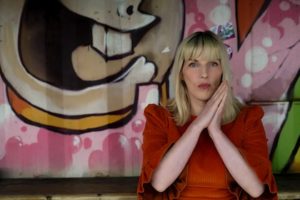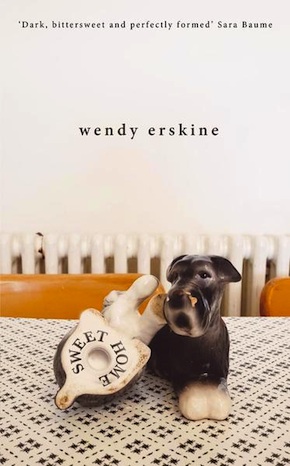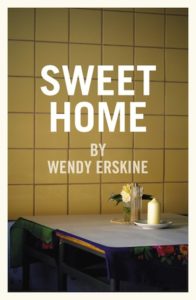Wendy Erskine: Beyond normal
by Alaia RotaecheWendy Erskine’s debut story collection Sweet Home, published last year by The Stinging Fly Press in Ireland and since picked up by Picador, combines intelligent lucidity, humour, fear, compassion and above all, what is it to be human. The stories are complicated yet simple; hilarious yet chilling; they deal with both our darkest nature and with ordinary life around Belfast. But, as she asks, what exactly is ordinary?
Her writing leaves you exposed. Her characters appeal in such a way that you end up wanting to know more about their lives. I found myself thinking about them days and weeks after I had finished the book. She writes brilliantly and gives new life to the short-story format, which is often underrated and disregarded by the big literary prizes.
AR: For those who don’t live in Belfast, or haven’t visited, how is the city reflected in your stories and characters?
WE: It’s a place where there are still centrifugal forces, polarising people from an early age. It’s a place where there is a history of violence being normalised. Like any post-conflict world, there are a lot of competing narratives and a lot of narratives that are untold, buried. That kind of stuff comes through in the stories, although mainly in an elliptical way.
That said, Belfast is also a place like any other where people suffer hurt and disappointment, where they experience elation and happiness. So much in the stories, most of it in fact, should be familiar to anyone from Paris to Berlin – and every disco I’ve been in.
I’m fascinated by the space in your stories: the houses, the streets, especially in ‘Inakeen’, for example, or ‘To All Their Dues’. How important is the spatial element in your work?
It is really crucial to me. I’m interested in domestic space particularly, and how the same houses are different homes. So many of my stories have doors as a significant aspect: closing the door on someone (like a mother), hoping that someone will let you cross their threshold, standing at the door wondering whether or not to let someone in. I like the idea of the home as a semi-autonomous statelet, with its own rules and regulations. I’ve always found other people’s homes really interesting in that regard. I think that comes through in a story like ‘Observation’ where the central character, a teenage girl, is involved in watching everything that goes on in her friend’s home. There are a lot of voyeuristic women in my writing.
In that sense, you create a world of its own, different in each story but with common elements. How much is fiction and how much is taken from the real world, or at least the writer’s real world?
It’s all fiction. Because none of the characters are based on anyone who exists in the real world. It’s all real. Because all of the characters could exist in the real world. I am not really interested in presenting stylised approximations of character, although obviously I know that realism is a mode as artificial as any other. I’m not a dope.
What I found most thrilling about the stories is that you kind of leave the characters to cope with life by themselves, and that’s something rarely seen in literature. Your stories are mostly open-ended. Was that a conscious choice or something that came along with the writing process itself?
What a wonderful thing to say. I am so delighted by that. I suppose I have spent a lot of time thinking about endings in relation to my own reading, you know, what I as a reader like and dislike. I don’t really like work where the whole point of the story is the ending, you know, the kind of thing where the last few paragraphs are the money-shot. I hate feeling that everything has been preparation for that. And it’s nearly always a disappointment.
At the same time, I am not really interested in writing mood pieces, which just seek to create a vibe. I suppose what I’m trying to do is co-opt the reader into creating meaning, most particularly in terms of future time and the trajectories they create for the characters. And so therefore, you are absolutely right, I leave the characters – and significantly, the readers, to cope for themselves. At an event a woman asked me if everything worked out all right for Barry from ‘The Soul Has No Skin’. The fact that she had engaged with the idea of his life post the story, I took to be a great compliment.
I think of surreal as the juxtaposition of incompatibles, and here we have the ordinary and the extraordinary co-existing.”
It seems that the characters have one particular thing in common: they are trying to cope with ordinary life, with nothing extraordinary on the surface. What did you want to explore with them, with their lives, and with the relationships between them?
Yes, that is true. They are trying to cope with ordinary life with nothing extraordinary on the surface. By so many indexes that would be the case. But then, at the same time, what is just ordinary? We have a woman making an attempt to join a Somali family she has never spoken to; a woman who as a teenager discovered her lover with his head shot off; a paramilitary using a Scottish pop star’s name as an alias at a hypnotherapy session. These things are surreal. I think of surreal as the juxtaposition of incompatibles, and here we have the ordinary and the extraordinary co-existing.
Many of the stories in the collection are quite chilling, but with ‘Arab States: Mind and Narrative’ I really jumped off the couch and couldn’t believe you left me hanging like that… How did you reach that character, Paula, and that story? Did you find her first or it was more about the story itself?
I really like the way you say, how did I ‘reach’ the character, or how did I ‘find’ her. It suggests pre-existence prior to appearing in a story. It’s tantamount to what Lisa McInerney says when she talks about ‘excavating’ a character. In this case I had been thinking about the whole idea of the midlife crisis. I’d heard Viv Albertine from the Slits talk about how it was always framed in a negative way but in fact it was a way of getting back to when an individual felt most alive and vital, and as such should perhaps be regarded as a commendable thing. So I was considering that idea, but also as well Death in Venice, which really is the midlife crisis story in excelsis. So Paula really developed as a result of those two particular influences.
How did these people, with so much life in them, and these stories begin to germinate in your head? How was the creative process? Did the characters tend to arrive first, then the stories, the place, etc.?
It varies in relation to the individual stories. With ‘Sweet Home’, I knew the general trajectory because it was a story based on ‘The New Villa’ by Chekhov. With ‘Inakeen’ I actually had a very clear visual sense of what I wanted the story to look like at the end. I had a strong sense of tableau there. But for the most part it would have to be the characters. I remember when I was at university and I was asked about a book, of Fielding or Richardson or something like that, and I talked mainly about the characters, who I liked, who I didn’t like. And my fine old professor said, “We should have got beyond talking about characters by now.” And of course he was right in that context, but there is a sense in which I haven’t ever really got too far beyond thinking about character. Before I put pen to paper, I will just spend about a month thinking about the people involved in a story. I just kind of internally live with them for a while.
Do you think that short stories give the writer a more flexible space to explore the common things, the crevices of daily life?
I think that yes, certainly they can do that. It is certainly possible to use the short story to consider fleeting things that could not withstand more expansive exploration in a novel. (Although so many long novels really just amount to extended short stories – said every short story writer ever!)
But I would say that the short story form is flexible in so many ways. It can be wildly experimental in ways that could not be sustained over the course of a novel. It can be expansive, dealing with decades, centuries if you want. It can slow time right down so that a few seconds constitute a half-hour reading experience, Eley Williams-style.
With a book of short stories, even one like mine where the actual locale of each story is fairly similar, you still have to recalibrate to a new world: the one of a particular home, or a particular shop.”
The short story format is often seen as a kind of preparation for the novel, for the ‘greatest’ literary genre, it seems. But I often think that short stories are much more relevant to our time, our themes and our worries, and it gives the writer a tool to explore a glimpse of the character’s life. Why do you think it’s an underrated format?
Supersize, jumbo, Xtra: people like big things. I was talking with the excellent Argentinian writer Fernando Sdrigotti about this and he was saying how he had come to see the size thing as a bourgeois marker of the privilege of time: both the reader’s and the writer’s. The reassuring heft of the leisure class. That could certainly be true.
There is a sense in which the novel might be a more immersive experience for some people, I suppose. You know, you enter a world and you remain in that world for the duration. Whereas with a book of short stories, even one like mine where the actual locale of each story is fairly similar, you still have to recalibrate to a new world: the one of a particular home, or a particular shop. But then that is the pleasure of the form for many people.
I don’t know what the themes and preoccupations of our time really are. I mean, I know what mine are, and I know what gets coverage in the media, but neither of those things can be considered anything other than partial.
I’m sure you get this question a lot, but I’m genuinely interested in it, so here it goes. Is there an Irish short story scene right now? Given your part in it, why do you think it has happened? Is it a cultural phenomenon or just a coincidence, in your opinion?
I think there is certainly interest in the short story in Ireland. There’s a short story festival in Cork, there are many short story competitions, there are literary journals publishing short stories, and then there is The Stinging Fly Press which publishes collections. So in a sense there is a kind of short-story ecosystem. I am surprised though that short stories are not more popular just generally because for me they are our usual mode of communication. You know, you meet a friend for coffee and essentially what you do is trade short stories. Without even thinking about it, most people know how to construct a good story because they tell them all the time.
To be honest I don’t know if I belong to an Irish short-story tradition, I maybe think of myself as a Rebel Inc. writer, decades too late.
Why do you think Northern Ireland is experiencing something of a literary boom right now, when it has always been a place with great authors?
It’s hard to know. Are there quantifiably more people writing in Northern Ireland now than there used to be? Is people’s writing mysteriously getting better? Or is it that publishing has evolved to a point where they can see a market for writing with an NI locale? I don’t know.
I think people are now more receptive to a variety of narratives regarding the place, but that presupposes that Northern Ireland writers are writing about Northern Ireland. Why should they necessarily? And in any case, probably my favourite books about Northern Ireland are written by people who aren’t from there: Chris Petit and the brilliant David Keenan. Also The Hired Man by Aminatta Forna, which is about Croatia. But also, in effect, about Northern Ireland.
What are your next plans regarding writing?
Well, I have a few short stories to write for various things. And some for myself too. I have also written non-fiction. The latest piece was on BBC Radio 3. People find my non-fiction pretty engaging I do believe, but it can never be true in the way that fiction is.
 Wendy Erskine’s work has been published in The Stinging Fly, Stinging Fly Stories and Female Lines: New Writing by Women from Northern Ireland. She has also featured in Being Various: New Irish Short Stories (Faber and Faber), Winter Papers and on BBC Radio 4. Sweet Home is published by Picador in hardback and audiobook. It has been shortlisted for The Republic of Consciousness Prize and The Edge Hill Prize, longlisted for The Gordon Burn Prize, and the story ‘Inakeen’ was longlisted for the Sunday Times Audible Short Story Prize.
Wendy Erskine’s work has been published in The Stinging Fly, Stinging Fly Stories and Female Lines: New Writing by Women from Northern Ireland. She has also featured in Being Various: New Irish Short Stories (Faber and Faber), Winter Papers and on BBC Radio 4. Sweet Home is published by Picador in hardback and audiobook. It has been shortlisted for The Republic of Consciousness Prize and The Edge Hill Prize, longlisted for The Gordon Burn Prize, and the story ‘Inakeen’ was longlisted for the Sunday Times Audible Short Story Prize.
Read more
@WednesdayErskin
Author portrait © Khara Pringle
Alaia Rotaeche is a culture journalist currently working in content creation and social media. Her main passions are literature and music. She lives in Madrid, where is completing a PhD in Literary Studies.
@aL_rc



